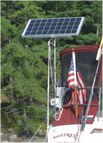 This year we tested our new 175 Watt SunPower cell solar panel with our integrated water heating system on a 6 week cruise in Northern Lake Huron at a latitude of about 46 degrees. We used an EP Xtra-N 20 amp MPPT Controller. The 175 watt panel provided plenty of power to meet our 70 amp hour per day requirements. The 175 watt panel was mounted using our CMP pole mounting system so I could tilt and rotate the panel to achieve optimum sun angle. I set the sun angle once and rotated the panel three times a day (morning, midday, evening) and estimate we got about 30% more performance over a fixed horizontally mounted panel. Operating statistics: Our power usage averaged approximately 70 amp hours or 850 watt hours in a 24 hour period. Our current draw was from a refrigerator/freezer running 24/7, our LED lights in the evening, cell phone chargers, laptop computer several hours a day and our radios and instruments during the day. Our windlass is only run when the engine is running so we don't include it in our power consumption calculation as the alternator quickly makes up for its power usage. We have a 75 amp Balmar alternator with a smart regulator. We changed our battery system this year by installing two 100 amp hour CMP LiFePo4 batteries for our house bank and one for our starting battery. I will post more about these batteries and our exciting findings soon. We started the engine to move anchorages about every three days. Results and findings: 1. Our battery bank was fully charged by 1 PM most sunny or mostly sunny days when at anchor. This is about the same charging time that we experienced last year with the 160 watt solar panel. 2. The EP Xtra-N MPPT controller with the remote display proved to be an outstanding piece of equipment. It was simple to program, easy to read, collected the appropriate data and was very efficient. It was exciting (I get excited about these things) to see 6 to 10 amps being poured into the battery bank in the morning. It would be frustrating to see it only outputting and amp or two in the afternoon in full sun but then you realize it is doing its job. It fully charged the batteries in the morning and was in float mode topping off the battery bank in the afternoon. 3. Because we have excess power in the afternoon on sunny days, we installed an inverter and purchased an ice maker. This turned out to be worthwhile purchase. Ice for drinks was a free luxury (power wise) that we really enjoyed. 4. Rotating the panel during the day, especially in the morning, significantly increased the power generation of the panel. 5. The data gathered confirmed that this panel configuration supplied all the power we needed and had excess capacity to catch up on battery charge after a string of cloudy days. 6. The panel was affected by shading as would be expected. Occasionally the panel was shaded by the back stay or the mast. While the shading was minimal, it degraded the performance by up to 40%. 7. We installed a new larger heat exchanger on the back of the panel for our water heating system This worked well on those sunny days so we had warm water for showers and dish washing. Power consumption of this system was minimal. Data: 175 Watt Solar Panel At anchor Motor Sunny to Cloudy to Mostly Sunny Mostly Cloudy Average watt hrs per day 750 480 900 435 Average amp hours per day 58 37 69 33 Maximum watt output in 24 hours 1,280 750 1,280 570 Maximum amp hours in 24 hours 98 58 98 44 160 Watt Solar Panel At anchor Motor Sunny to Cloudy to Mostly Sunny Mostly Cloudy Average watt hrs per day 660 480 700 400 Average amp hours per day 51 37 54 31 Maximum watt output in 24 hours 1,210 770 1,210 770 Maximum amp hours in 24 hours 93 59 93 59 Observations: 1. The minimum watt hour output doesn't mean much because it is dependent on both the cloud cover and the state of charge of the bank as a result of alternator charging, 2. The maximum watt hours per day of 1,280 is not the maximum output capacity of the system in a 24 hour period because the batteries were charged by 1 PM so the controller shut down the charge from the panel. A higher drain on the house battery bank would have resulted in this number being higher. 3. Average amp hours per day is computed by dividing the watt hours by 13 volts. This is a ballpark calculation. 4. This configuration proved to have plenty of capacity for our cruising needs even without using an auxiliary flexible solar panel we store under a bunk. We did not use shore power to charge our battery bank for the entire summer. Solar Water Heater: We installed our new solar water heating system. It consists of a heat collector or heat exchanger mounted on the back of the solar panel, and a circulating pump. See our earlier blog for design considerations. The pump circulates water from the water heater through the heat exchanger on the panel. We used the same configuration on our 120 watt panel last year. Results: On sunny days at anchor we had warm water for showers and dish washing. The water temperature in our 6 gallon hot water tank would warm from 60 degrees to about 105 degrees in 2-3 hours on a sunny calm day. As expected, we confirmed that strong winds tend to cool the panel and reduce the heating efficiency as do clouds. Overall, the water heating system cools the surface of the panel by at least 20 degrees. This increases the efficiency of the panel since solar panel performance degrades as they are heated by the sun. Insulating the tubing running between the heat exchanger and the water heater significantly increased the efficiency of the system. In conclusion, the radiant energy water heating system works well on sunny days with both our larger and our standard sized panels. See our product section or read our earlier blog for details.
0 Comments
This was the second year we used the 160 Watt solar panel on a 35 day cruise in the North Channel area of Northern Lake Huron. The boat equipment and cruising pattern was essentially the same as last year (See prior blog entries). The solar panel performance was comparable to last year with a few minor exceptions. The data comparing the performance of the 160 Watt panel during 2013 and 2014 and the 140 Watt panel in 2012 is displayed below.
Average amp hours per day produced under various conditions: 140 Watt, poly 160 Watt, mono 160 Watt, mono 2012 2013 2014 Overall average output per day 53 amp hours 48 amp hours 48 amp hours Sunny days 69 71 69 Mostly sunny days 50 50 56 Mostly cloudy days 35 37 39 Cloudy days 32 28 20 Avg. Output on days at anchor 62 61 51 Avg. Output when engine was used 43 44 45 (We had more cloudy days at anchor this year) Min amp hrs for a day 27 28 4 Max amp hrs for a day 74 77 76 Max amps output 10.5 amps 11.5 amps 11.4 amps This data is intended to provide a general idea of what to expect from the marine solar panels under various conditions. The two primary variables are the amount of sunshine and the running of the engine (the alternator charges the batteries so the controller shuts the panels down). The test boat was running a freezer/refrigerator drawing 5 amps running 6 hours a day, LED lighting, laptop computer drawing 4 amps running 3 hours a day, radios drawing 3 amps running 8 hours a day, and instruments and autopilot when under sail and power. When at anchor on a sunny to mostly sunny day our batteries were at full charge by 2 PM so we usually had excess power. At other places on this blog and on our web site we talk about how to determine the size of solar panel (how many watts) you will need to meet you power consumption requirements. Once you know your panel size requirement there are some things to consider in selecting a solar panel.
Panel Type - There are many articles written on the two types of solar panels; monocrystalline and polycrystalline. Monocrystalline panels are made up of single crystal silicon wafers. Polycrystalline panels are made up of silicon that has a multiple crystalline structure. There are pros and cons to each type of panel. Monocrystalline panels have a higher output per square inch in direct sun but are very sensitive to shading and output will degrade faster on cloudy days. Polycrystalline panels are not as sensitive to being shaded and output will not degrade as much on cloudy days. At CMP we offer both a polycrystalline and a monocrystalline panel. Panel Crystal Quality - Because we have a confined space on our boats, we need to have the maximum output per square inch from our solar panels. The quality of the silicon crystals used to make the panel is a key factor in determining the panel output. Crystals are passed under a fixed light and graded as to their output (1-10). Grades are grouped into classes. Class A crystals are grades 8-10, Class B crystals are grades 4-7 and so on. Crystal quality follows a bell curve; there are many more Class B crystals than Class A. We at CMP specify only the best Class A crystals for use in our panels. Less expensive Class B and C panels are often used on land based solar farms where space is not an issue. Panel Shape - The largest market for solar panels is commercial applications where many many panels are mounted on a roof or in a field. These panels are usually rectangular in shape often twice as long as wide. This shape is often not ideal for marine application. Often a more square shape is preferable, especially for pole mounting. Choosing the right panel for your needs will require study and/or discussion with panel experts. |
Categories
All
AuthorThomas Trimmer has been cruising with his Ericson 38 sailboat on the Great Lakes for over 20 years. He has pioneered the use of solar energy for wilderness cruising. He is continually designing and building equipment to simplify and enhance the cruising experience. Archives
April 2024
|
Efficiently Powering Your Vessel/Van. Call/email/chat any time, we're happy to help you work through designing your solar system.
Home Page Solar Panels Mounting Kits Product Page Marine Solar Systems Gallery of Installations Customer Comments Contact Us
Call 248 705-8337 or email [email protected]
Article On How To Size Your Solar Panels For Your Boat
Customer Reviews Return Policy Privacy Policy Shipping Times/Rates
Home Page Solar Panels Mounting Kits Product Page Marine Solar Systems Gallery of Installations Customer Comments Contact Us
Call 248 705-8337 or email [email protected]
Article On How To Size Your Solar Panels For Your Boat
Customer Reviews Return Policy Privacy Policy Shipping Times/Rates

 RSS Feed
RSS Feed